«Women soon used their needle skills to connect the domestic sphere with the public sphere of collective social action. […] May the tips of our needles prick the consciences of the slave masters» declared Sarah Grimké, one of the first women to speak out publicly against slavery. Art historian Whitney Chadwick collects data of great interest for a feminist reading of Western artistic practices in her work Woman, Art and Society (1990). Moving on to the introductory quote, a quote that encompasses another within it, Chadwick talks about the importance of weaving and embroidery in 19th century America. Associated with the feminine sphere, the intimate world of women from the patriarchal tradition, they became tools to claim women’s rights in relation to work and to defend the equality and freedom of people in slavery.
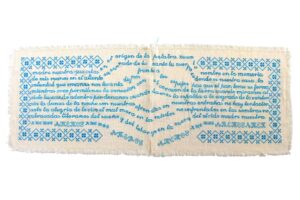
Mercedes Bautista, “Madre nuestra”, 2020-2021. Cross-stitch embroidery of the poem “Madre nuestra” written by the artist, courtesy Cozumel Musem
In this respect, Mercedes Bautista (Madrid, 1966) maintains a similar line of recovery of weaving and embroidery as arts that are historically and even interculturally linked to women, so they are useful for raising awareness. In addition, she has other parallel objectives: she cultivates them strategically to defend the feminist cause, the plurality of native cultures against globalization and a way of life that is respectful of nature. El Cuerpo de lo Poético: 2013-2023 at the Museo de la Isla de Cozumel, Mexico is a very complete retrospective exhibition in which there are examples of Bautista’s textile art, highlighting the banners and huipiles (sleeveless blouse, ornamented, typical of some Mexican indigenous cultures, such as the Maya), that capture poems written by the author. Our protagonist is a multifaceted artist, who places great importance on the conceptual background of her works.
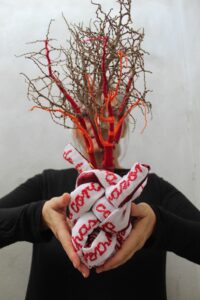
Mercedes Bautista, “De tripas corazón”, 2020. Photography with poetic object, 100 x 70 cm, courtesy Cozumel Musem
For Bautista, the aesthetic aspect is usually not transcendental, nor does it want to please us through the superficiality of artistic beauty, because its main purpose is to convey a very clear message, without artifice. It manifests itself in the choice and correct use of materials and techniques and also through the inclusion of texts and iconographies linked to the female imagination, such as the homonymous article published in 1973 by the artists Judy Chicago and Miriam Schapiro, in which they defend the presence of the vulva as an iconographic element to enhance the anatomy of women and the fight against phallocentrism and the mistreatment of the female genitals and other parts of the body associated with women such as the breast. It is also important to highlight the relationship between her favourite artistic techniques —weaving and embroidery— and the addition of texts in her works, which refers to the etymological link between the words textile and text; they both come from the Proto-Indo-European root *teḱ, which means ‘’to engender’’. Not only because of the relationship between women and life —women as the only ones capable of giving life— but above all because both weaving and writing are processes of engendering, of materializing an idea.
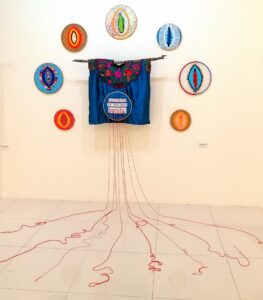
Mercedes Bautista, “Calladita te ves más bonita”, 2017-2018. Huipil from Guerrero intervened with embroidery and eigth tondos of seed-vulva-moon goddesses (also embroideries), courtesy Cozumel Musem
Her literary aspect, in fact, is also the textual unfolding of the female imagination of Chicago and Schapiro; the works cited show poems dedicated to the cult of the vulva-vagina, of the woman as the indisputable giver of life and affected by machismo. What is proposed is not a simple vision based on biological difference, but an alternative cosmogony in the 21st century, an era in which the great religions that have been operating for millennia tend to relegate, explicitly or subtly, women to the background compared to men, maintaining the validity of patriarchy. Her embroidered texts also extol the value of nature and its preservation, mentioning the relevance of Mother Earth —which is the eternal vital-nutrient element of the human being, to which the utmost respect is due in a kind of deification of it—. A cosmogony based, in short, on the capital of ecofeminism and the conservation of pre-colonized cultures still alive; a personal belief, that transforms the global through her art to sensitize the public.
Andrea García Casal
Info:
Mercedes Bautista. El Cuerpo de lo Poético: 2013-2023
25/01 – 3/04/2024
Cozumel Musem
Av. Rafael E. Melgar 321-Planta Alta, entre calle 4 y 6 Norte, Centro, 77600 Cozumel, Q.R., Messico

is a contemporary art magazine since 1980


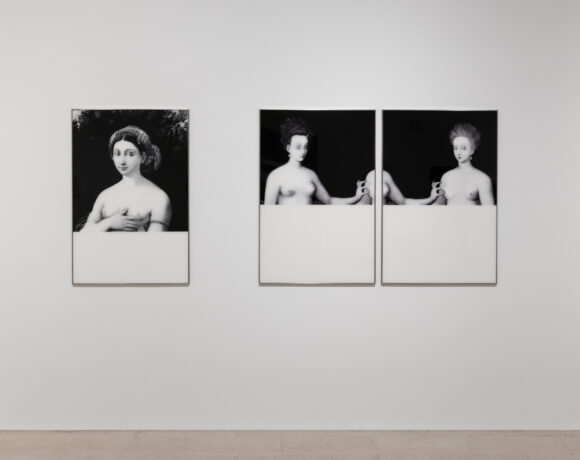
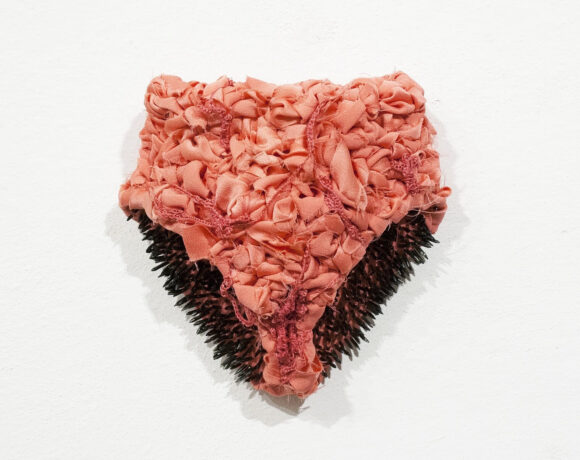


NO COMMENT